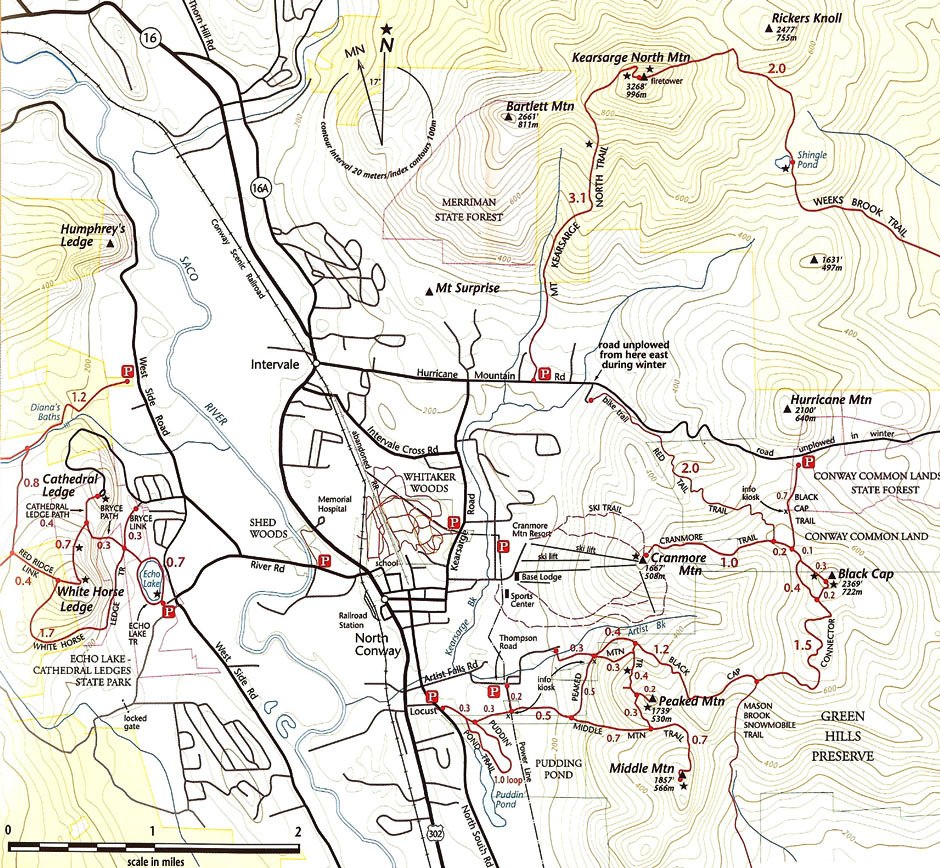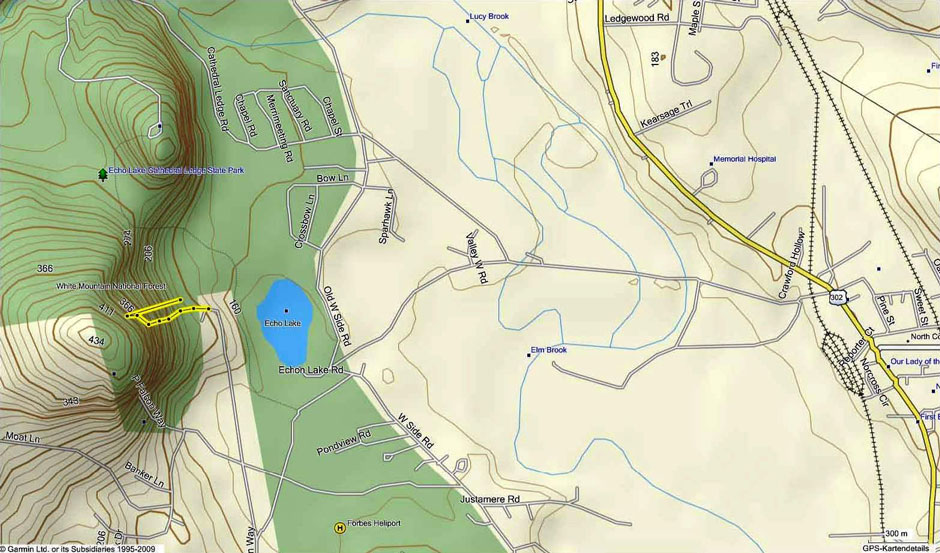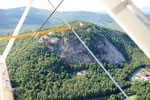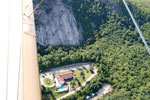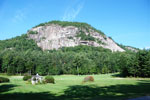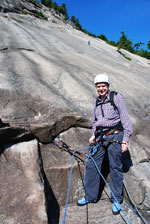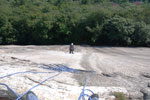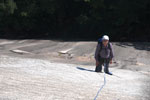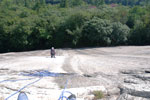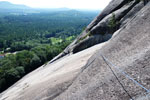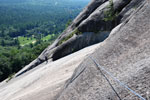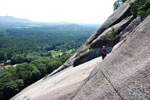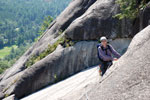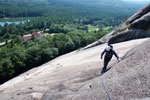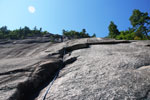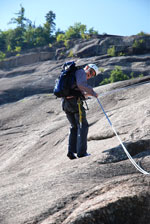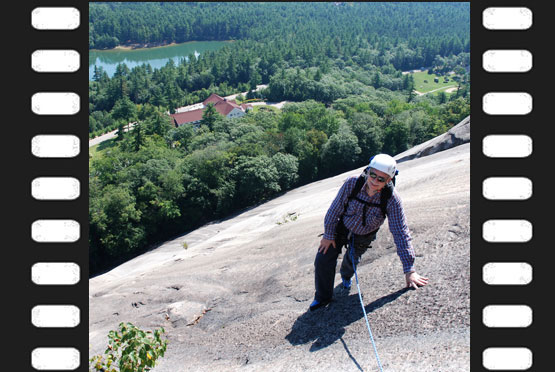| Whitehorse Ledge, Standard Route: Beschreibung | Top ↑ |
| Berg / Ziel:
Whitehors Ledge, Standardroute II |
Höhe in m:
462 |
||||||||||||||||||
| Land:
USA |
Region:
New Hampshire |
Gebiet:
White Mountains |
|||||||||||||||||
| Schwierigkeit:
YDS 5.4 |
Gesamthöhenmeter:
202/207 |
Gesamtzeit hh:mm:
3:00/3:40 |
Anforderung:
schwierig |
Exposition:
SO |
Gestein:
Granit |
||||||||||||||
| Fun:
sehr schön |
Sicherung:
super Fels |
Gefahren: | |||||||||||||||||
| Ausgangspunkt:
Parkplatz beim Hotel |
Höhe in m:
165 |
||||||||||||||||||
| Stützpunkt: | Höhe in m:
162 |
||||||||||||||||||
|
Literatur: Rock Climbs in the White Mountains of New Hampshire, by Edward R. Webster |
||||||||||||||||||
|
Karten: Map Adventures Outdoor Maps & Guides; White Mountains; New Hampshire & Main |
||||||||||||||||||
|
Talort / Info: North Conway |
||||||||||||||||||
|
GPS-Daten (UTM WGS84): |
||||||||||||||||||
|
|||||||||||||||||||
|
|
||||||||||||||||||
| Allgemeines: The single most popular rock climb in the White Mountains ascends the prominent, right-curving arch in the center of the Whitehorse Slabs. After several enjoyable, moderate pitches of friction climbing, the final series ofoverlaps are the crux.Although this is by far the best protected route on the Slabs, careful route finding is still necessary, especially on the crux pitch, the Brown Spot and the Boilerplate, to ensure a successful ascent. Hike through the woods until you are below the middle of the slabs and the large, central arch. Scramble 150 feet up an easy despression or trough to a comfortable, flat platform known as the Starting Ledge. There are a multitude of variations passible throught the climb. Carry a normal rack with extra slings. History: In the Spring of 1928, Robert L. M. Underhill, Herbert C. Towle, & John Holden, Jr. climbed to the top of the arch, but were thwarted by a sudden cloudburst. With only rope for the three of them, the descent down the wet slabs proved memorable. Underhill lowered his partners the full rope length to the only ledge in sight, wrapped his end of the rope around a small tree, carefully lowered himself to the halfway point - and let go the other end of the rope! He had hoped the friction of the rope sliding around the tree would slow him down. It didn't! As he began to accelerate out of control, the well-muscled Holden fortunately "reached out and tackled me onto the ledge. It was then I realized how helpful it was to have brought a football player along," Underhill recalled. In October, 1929, Robert Underhill & Kenneth Henderson descended the summit slabs, tied a rope onto a convenient pine, rappelled down, the navigated through the final overlaps above the Brown Spot. Their rope, however, was left in place, allowing subsequent parties to hand-over-hand up it, and finish the climb through the troublesome overlaps. Henderson and Underhill realized they had not made a "legitimate" ascebt, and advocated that "a few fixed pitons, judiciously placed where they could be lassoed from below make possible this 30 or 40 feet." The Brown Spot, today's UDS 5.5 crux, "throught unclimbable a short time ago," admitted Underhill, was finally free climbed by Leland W. Pollock, leading an AMC party, on July 2, 1932. |
|||||||||||||||||||
| Anreise: Zum unteren Parkplatz beim Hotel. Siehe Karte |
|||||||||||||||||||
| Zustieg: über einen Waldweg zum Whitehorse Ledge. |
|||||||||||||||||||
| Route: 1. From the right end of the Starting Ledge (piton), friction up and right to a large pothole nicknamed the Toilet Bowl, which has a two bolt anchor. 80’, YDS 5.3. 2. Friction up and left past a flake to good ledges at the base of the main STANDARD ROUTE arch, and a double ring bolt anchor. 90’, YDS 5.2. 3. Layback up the back of the arch (YDS 5.4) to an awkward, semi-hanging belay (piton), or traverse right (YDS 5.3) to THE QUARZ POCKET belay stance which has a double bolt anchor. 145’, YDS 5.3 or 5.4. 4. Angle up and right along the arch up friction slabs to a sloping belay stance at fixed slings around a natural thread anchor. 100’, YDS 5.3. 5. An easy slab leads up and right to the top of the main arch. A short, steep section up a dike gains the famed Lunch Ledge which has a double ring bolt anchor below the route’s hardest section, the final overlaps – and the famed Brown Spot and Boilerplate. 140’ YDS 5.3. 6. The crux pitch is next. The Brown Spot is the easiest finish, but since there are also several harder finishes, careful route finding is necessary. For the Brown Spot (YDS 5.5): climb up 15 feet from the right end of Lunch Ledge, make one thin friction move right to a bolt, the down climb a ramp for 10 Feet. Step right onto a narrow, brownish foothold (the Brown Spot) to another bolt, then climb a delicate slab (the Boilerplate YDS 5.5) onto a left-diagonalling ramp with several old pitons. Either belay at the base of the ramp at fixed pitons (rope drag can be a problem above), or follow the ramp up and left to a short, layback corner (which is also YDS 5.5). Most parties belay on a small stance just above this short corner, and slightly to the left. (Nut anchor). 150’, YDS 5.5. 7. Friction 40 feet left, traversing across an easy slab using a handrail-like flake beneath an overlap to reach an easy dike, and belay on the comfortable ledge above (with a good nut anchor) at the base of the upper slabs. 80’, YDS 5.2. 8. Follow the easy, stepped dike straight up to another overlap and a small pine tree. Bypass them on the left (or climb directly over the overlap at a double crack; one YDS 5.5 move) to a tree ledge. 140’, YDS 5.2 R. 9. Finish by climbing up either of the two, upper dikes in the summit slabs. The easier of the two finishes is up the left-hand dike, although the right-hand dike is also fairly straightforward. 250’, YDS 5.2 R. |
|||||||||||||||||||
| Abstieg: Am besten abseilen. |
|||||||||||||||||||
| Whitehorse Ledge, Standard Route: Bilder | Top ↑ |
| Impressum | Gästebuch | Ziele/Pläne | Allgemeines | Sitemap | Suchen | Top ↑ |
